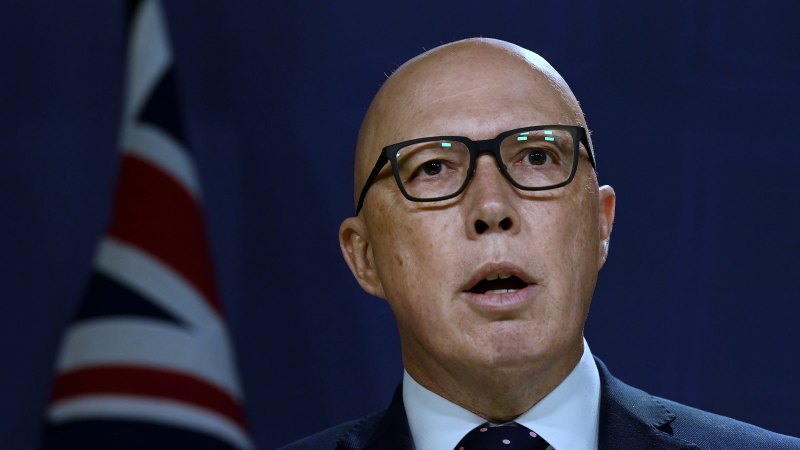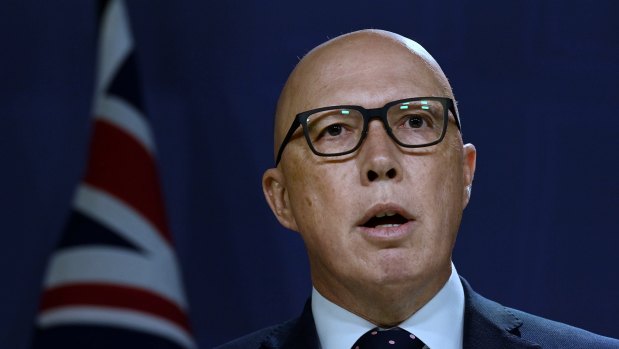Save articles for later
Add articles to your saved list and come back to them any time.
A single number highlights the scope for crime and exploitation in the Australian visa system after years of neglect. It reveals a troubling practice that has swollen the ranks of a hidden underclass of workers living in legal limbo. And it goes to the heart of an argument about whether Peter Dutton was part of the problem.
The number is 105,000, and it represents all the migrants in Australia who are waiting for decisions on applications for protection visas – in other words, claims for asylum. It does not tell us how many will be found to have genuine cause to stay as refugees, nor does it explain why they are waiting up to 11 years to have their cases decided. But it does reveal the scale of a challenge that has been ignored too long.
Opposition Leader Peter Dutton: he can’t escape blame for much of the immigration problem. Credit: Kate Geraghty
The opposition leader made an audacious claim this week to blame Labor for creating the mess. “Why did they lose control of our borders when they were in government?” he asked. “Why have they allowed 105,000 asylum seekers into our country over the last 15 months?” Angry that his record was under scrutiny, he let fly with a wild accusation against the other side.
The facts show his claim to be false. The official figures from the Department of Home Affairs, which Dutton used to oversee, confirm that the asylum seeker numbers are the result of years of failure rather than a mere 15 months of Labor rule. So Dutton was leading with his chin – and this is just a hint at how fierce and bitter the migration debate will become before the next election.
Labor will need to show it has the migration system under control – more on that below – but the debate has to start with facts, not falsehoods. The truth is that the strain on the system grew worse when Dutton was immigration and border protection minister from December 2014 to August 2018 and minister for home affairs from December 2017 to March 2021.
The asylum seeker numbers reached 94,260 at the time of the election in May last year, according to official figures checked by Abul Rizvi, a regular commentator on migration policy and a former deputy secretary of the Department of Immigration. Another 10,416 were added to the total since Labor took power. Rizvi concludes that Dutton’s statement is “patently untrue” because most of the arrivals came on the Coalition’s watch.
Does it matter? Yes, because political debate is toxic enough without fuelling the misinformation. Dutton’s claim was an example of the casual mistruth he has been uttering too often, such as his assertion that Prime Minister Anthony Albanese has Qantas chief Alan Joyce to dinner at The Lodge or that the question about the Voice could be changed in time for the October 14 referendum. He throws these into an interview or media appearance in the knowledge the conversation will move on and few will bother to check his claims. They are like drive-by lies.
There is a bigger reason for checking the numbers. History shows that 90 per cent of asylum seeker claims are rejected but that the applications can take years to resolve, which means the entire system creates an incentive for visitors to lodge claims that allow them to gain working rights for many years. There is a blizzard of data about migration, so it is worth noting that there have been 23,882 new asylum applications from June 2022 to August 2023, a rough guide to what has happened under Labor. What is important, says Rizvi, is that many of these applicants were already in the country. They did not “arrive” under Labor.
The government calculates that an application for asylum takes 2.4 years on average at the Department of Home Affairs, followed by 3.6 years if the applicant seeks a merit review at the Administrative Appeals Tribunal, then up to five years if it goes to a judicial review at the Federal Court. That is under the rules set when the Coalition was in power.
The flaw is simple. Visitors can enter the country with the help of an agent overseas who arranges their electronic travel authority to get them onto the plane and through the airport when they land. Once here, those visitors can extend their stay in several different ways, such as signing up for a “ghost college” on a student visa or claiming asylum – sometimes arranged by a criminal syndicate and migration agent. They have work rights during the years it takes for an asylum claim to be decided.
The exploitation can be horrific. Human traffickers in the sex industry, for instance, can confiscate a migrant’s passport upon arrival and treat them as slave workers. This was the experience for Karen, a woman from South Korea who told her story in the Trafficked series in this masthead last year.
When Rizvi checked the number of asylum seekers in the country at the time of the last election, he calculated that 26,405 were at the primary stage at the Department of Home Affairs, another 36,708 were waiting on reviews at the Administrative Appeals Tribunal and 31,147 had been rejected at both the primary and AAT stages but were pursuing appeals in the courts or chosen not go leave.
That last number is a special concern because it highlights the way the reality on the ground can be so different from the policy theory in Canberra. Even when officials refuse a visa, they can struggle to find and deport the individual. This means the nation has a swelling cohort of migrants who are totally vulnerable to exploitation because they have no legal right to remain.
One dire future, if the courts reject the applications but migrants refuse to leave, is a path to a permanent underclass – the American model of the illegal migrant who gets by with odd jobs. What will happen in a decade? Will a future government have to offer an amnesty for illegal workers?
Dutton has to answer for this problem. The warnings about onshore asylum seeker claims go back years. This masthead reported the long delay in making decisions in December 2018, then the rise to 95,000 asylum seekers in October 2019. The Coalition takes credit for stopping the boats at sea, so it must take responsibility for nine years of management of the entry points on land.
Many of these migrants will be found to be genuine refugees who are forced to wait years in a system that is congested with claims that are found to have no merit. If 90 per cent of applications are ultimately rejected – by courts, not just officials – the system clearly has too many false claims.
Home Affairs Minister Clare O’Neil and Immigration Minister Andrew Giles now promise a better way forward, although it is mostly about spending $159 million to speed up decisions in their department and at the tribunals and courts. But how will officials find and deport those without genuine claims? Will these new steps actually curb the number of visitors making false claims in the first place?
Labor should have acted more quickly. O’Neil and Giles received a report from former Victorian police commissioner Christine Nixon in March, in response to media reports about the problem last October, but they took seven months to develop their response.
Broader changes will have to wait until after the Voice referendum, when O’Neil and Giles move to simplify the overall visa system in response to a review led by Martin Parkinson, formerly Treasury secretary and head of the Department of Prime Minister and Cabinet. In the meantime, annual net migration has crashed through Labor’s forecast of 400,000 and reached as many as 500,000 people.
This mess has been years in the making and will be years in the fixing. If it is too slow, Labor will get to the next election without being able to demonstrate solid results from its changes. Too late, it may discover that blaming Dutton for the problem only works if it can prove it has a solution.
David Crowe is chief political correspondent.
Most Viewed in Politics
From our partners
Source: Read Full Article

